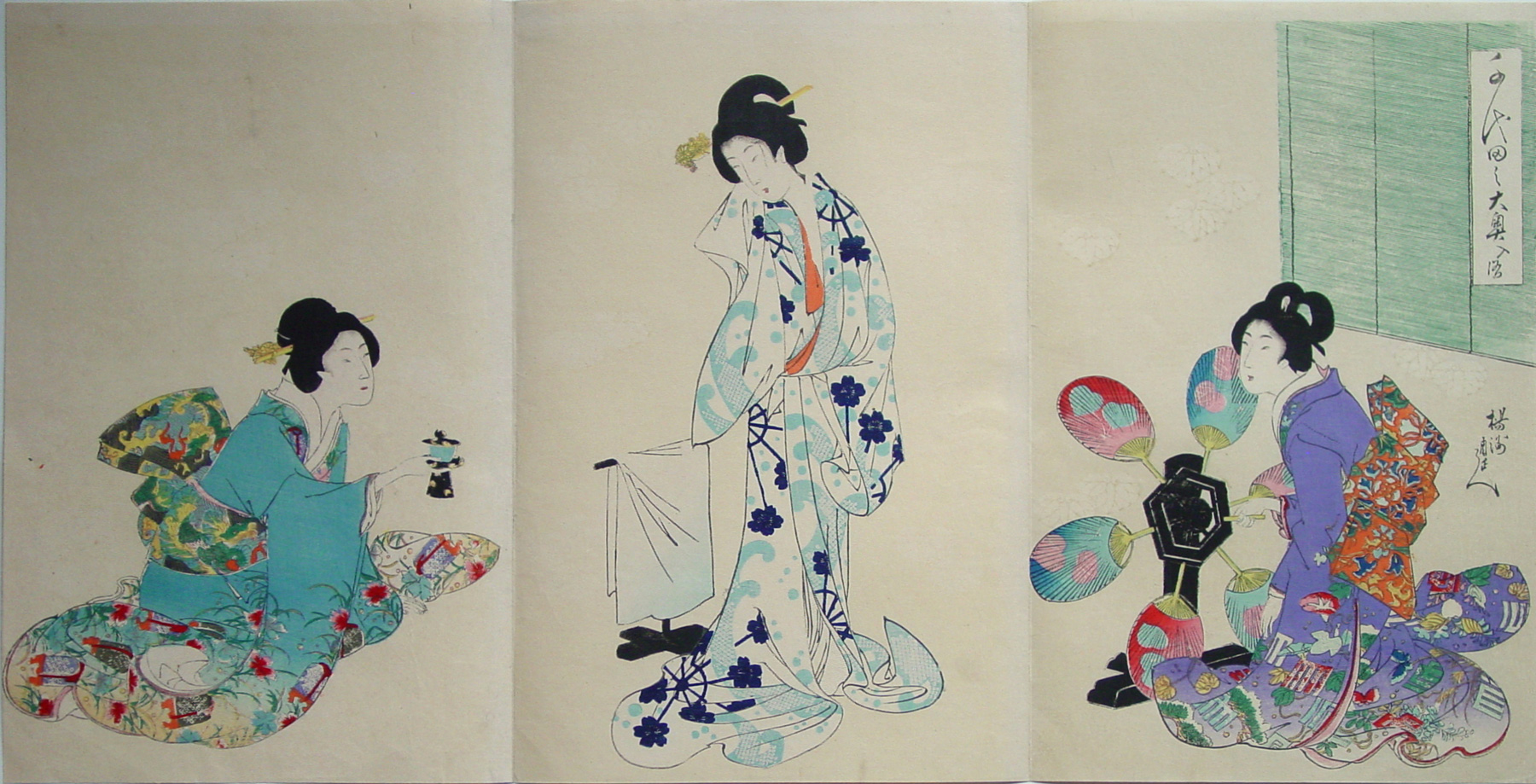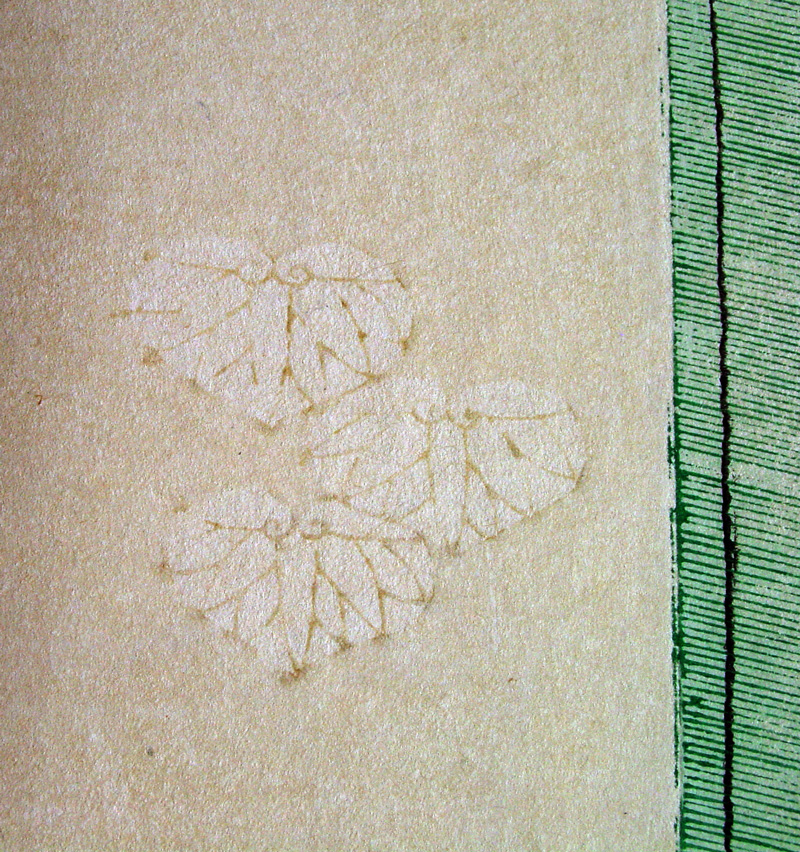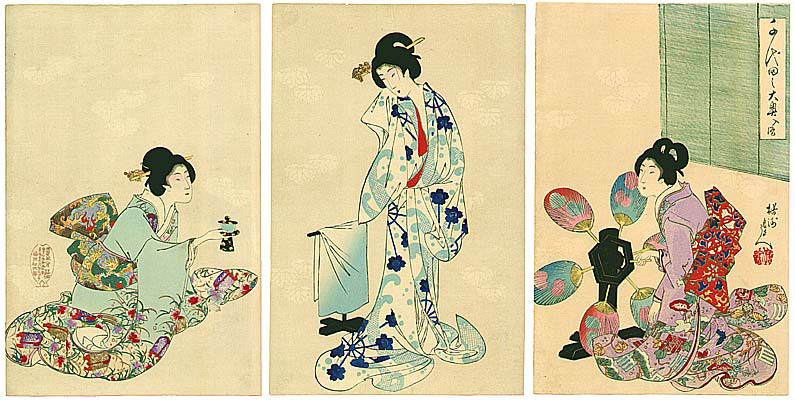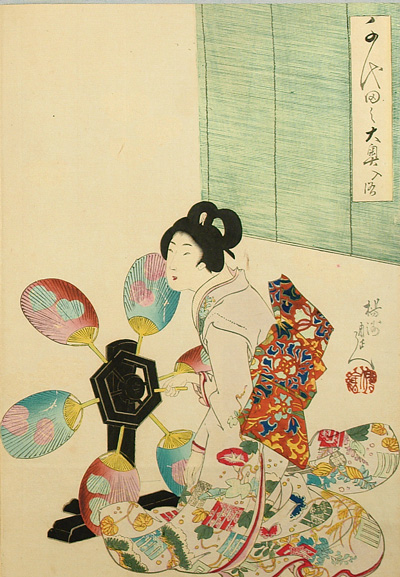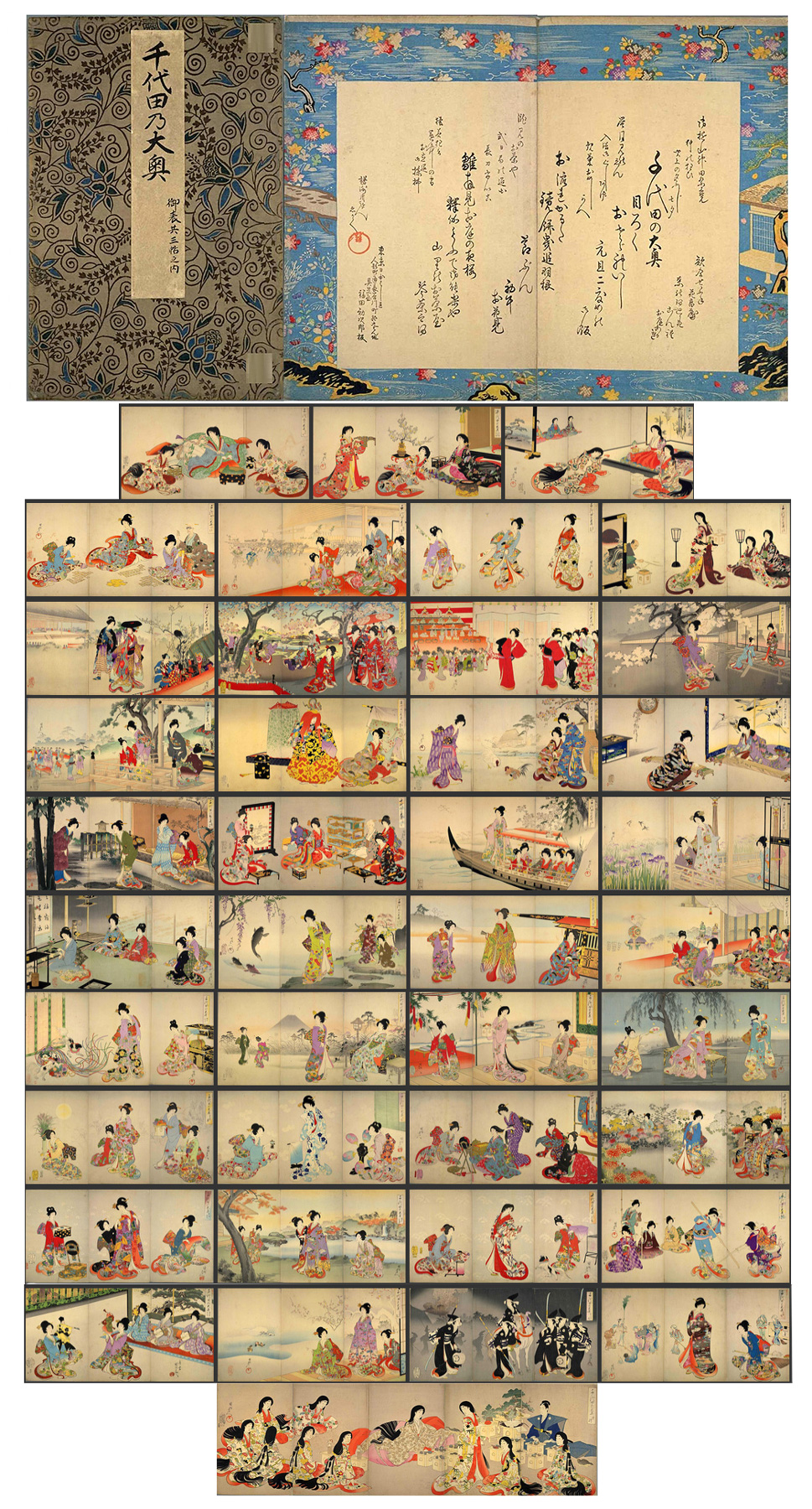About This Print
This print is from a series of 40 scenes documenting life inside the women quarters of the shogun's palace in Edo, prior to the Meiji Restoration in 1868. It shows a young beauty after her bath, wearing a blue and white cotton kimono, a towel on a stand next to her. An attendant offers her a cup of tea, while another turns the handle of a fan to cool her. A faint pattern of hollyhock leaves (as shown below), symbol of the Tokugawa Shogunate, is printed in the background. As with other prints in this series, this print exists in at least one different state, as shown below.A Lady's Toilette
Source: Secrets of the Shogun's Harem, Leslie Downer http://www.lesleydowner.com/journalism/secrets-of-the-shoguns-harem/Daily life in the palace was a picture of elegance. The ladies spent their mornings at their toilette, preparing for the shogun’s three daily visits. Each had maids to help her. The first job was to shave her eyebrows and freshen up the blacking on her teeth. At that time all adult women blackened their teeth with a dye of sumac-leaf gall, sake and iron. A woman with unpainted teeth would have looked barbarous.
Next the maid painted the lady’s face with white make up. She outlined her eyes in black, rouged her cheeks and dabbed red safflower paste on her lips, then oiled and combed her long glossy hair and coiled it into a knot. There were different hairstyles for each rank and also different styles of kimono.
Other Impressions
| Impression with publisher's seal left panel and artist's seal right panel, which are not present in this collection's print. | State with different coloration of robe worn by figure in right panel |
About The Series
click on image to enlargeAfter completion of the series in 1896 the publisher compiled albums of all forty prints, plus a table of contents. "In the series "The Inner Precincts of Chiyoda," Chikanobu imagines something he never saw—the inner precincts of Edo Castle, which housed the shogun’s mother, wife, and concubines. The area was off limits to all men other than the shogun himself or his young male heir."1
"The Chiyoda Inner Palace (Chiyoda no Ōoku) series of 1895-1896, together with his 1897 series Chiyoda Outer Palace (Chiyoda no on-omote) provided detailed depictions of life in and around Edo Castle before the Meiji Restoration of 1868. In the Chiyoda Inner Palace set, Chikanobu documented various annual ceremonies in the women’s quarters, especially those at New Year’s, and seasonal activities, particularly those conducted in the palace gardens. While Chikanobu did not indicate specific events or name certain people that would link these images to a single date or time period, the scenes give an overall impression of what the shogun’s private quarters might have looked like in the mid-19th century.
"Most women depicted in Chiyoda Inner Palace are portrayed as elegant dignified ideal feminine figures, showing little emotion or excitement. No one seems happy or sad, ebullient or upset. In fact, these imaginary depictions suggest a realm of tranquil harmony, without conflict or illness. Only two old women are shown, and most of the more than 150 featured figures are youthful looking, appearing to be in their 20’s or early 30’s. A few girls are present, but even they are well behaved; no babies or pregnant women are evident. There is a sense of tension among the women, though, as ritual gestures and prescribed ceremonies are carried out with great seriousness. Although some settings are animated by secondary figures (servants,
actors, parade participants, etc.) or pet animals, overall the quiet rhythm of life in the Chiyoda Inner Palace is predominant and well described."2
click on image to enlarge After completion of the series in 1896 the publisher compiled albums of all forty prints, plus a table of contents. | "In the series "The Inner Precincts of Chiyoda," Chikanobu imagines something he never saw—the inner precincts of Edo Castle, which housed the shogun’s mother, wife, and concubines. The area was off limits to all men other than the shogun himself or his young male heir."1 "The Chiyoda Inner Palace (Chiyoda no Ōoku) series of 1895-1896, together with his 1897 series Chiyoda Outer Palace (Chiyoda no on-omote) provided detailed depictions of life in and around Edo Castle before the Meiji Restoration of 1868. In the Chiyoda Inner Palace set, Chikanobu documented various annual ceremonies in the women’s quarters, especially those at New Year’s, and seasonal activities, particularly those conducted in the palace gardens. While Chikanobu did not indicate specific events or name certain people that would link these images to a single date or time period, the scenes give an overall impression of what the shogun’s private quarters might have looked like in the mid-19th century. "Most women depicted in Chiyoda Inner Palace are portrayed as elegant dignified ideal feminine figures, showing little emotion or excitement. No one seems happy or sad, ebullient or upset. In fact, these imaginary depictions suggest a realm of tranquil harmony, without conflict or illness. Only two old women are shown, and most of the more than 150 featured figures are youthful looking, appearing to be in their 20’s or early 30’s. A few girls are present, but even they are well behaved; no babies or pregnant women are evident. There is a sense of tension among the women, though, as ritual gestures and prescribed ceremonies are carried out with great seriousness. Although some settings are animated by secondary figures (servants, |
Chiyoda Palace History
Source: Wikipedia http://en.wikipedia.org/wiki/Edo_CastleChiyoda Castle (千代田城, Chiyoda-jō) also known as Edo Castle (江戸城, Edo-jō), is a flatland castle that was built in 1457 by Ōta Dōkan. It is located in Chiyoda in Tokyo, then known as Edo, Toshima District, Musashi Province. Tokugawa Ieyasu established the Tokugawa shogunate here. It was the residence of the shogun and location of the shogunate, and also functioned as the military capital during the Edo period of Japanese history.
After the capitulation of the shogunate in 1867, the inhabitants including the shogun had to vacate the premises. The castle compound was renamed Tokyo Castle (東京城, Tokyo-jō) in October, 1868, and then renamed Imperial Castle (皇城, Kōjō) in 1869. In the year Meiji 2 (1868), on the 23rd day of the 10th month, the emperor moved to Tokyo and Edo castle became an imperial palace.
1 Portland Art Museum http://portlandartmuseum.us/mwebcgi/mweb.exe?request=record;id=46772;type=101
2 Chikanobu – Modernity and Nostalgia in Japanese Prints, Bruce A. Coats, Hotei Publishing, 2006, p. 169.
Print Details
| IHL Catalog | #302 |
| Title or Description | After the Bath nyūyoku 入浴 |
| Series | Chiyoda Inner Palace Chiyoda no Ōoku 千代田の大奥 |
| Artist | Yōshū Chikanobu (1838-1912) |
| Signature |  |
| Seal | no seal |
| Publication Date | 1895 August (Meiji 28) |
| Publisher | Fukuda Hatsujirō 福田初二郎 [Marks: pub. ref. 070; seal ref. 062] |
| Impression | excellent |
| Colors | excellent |
| Condition | good – three sheets joined, each sheet full-size, unbacked |
| Genre | ukiyo-e |
| Miscellaneous | |
| Format | vertical oban triptych |
| H x W Paper | 14 3/8 in. x 28 1/4 in. (36.5 cm x 71.8 cm) |
| Literature | |
| Collections This Print | The Metropolitan Museum of Art JP3549; Ritsumeikan University ARC 国会668-00-094 国会668-00-095 国会668-00-096; Shizuoka Prefectural Central Library K915-108-031-015; Bunka Gakuen University Library Digital Archive of Rare Materials BB30019798 |
4/25/2020


